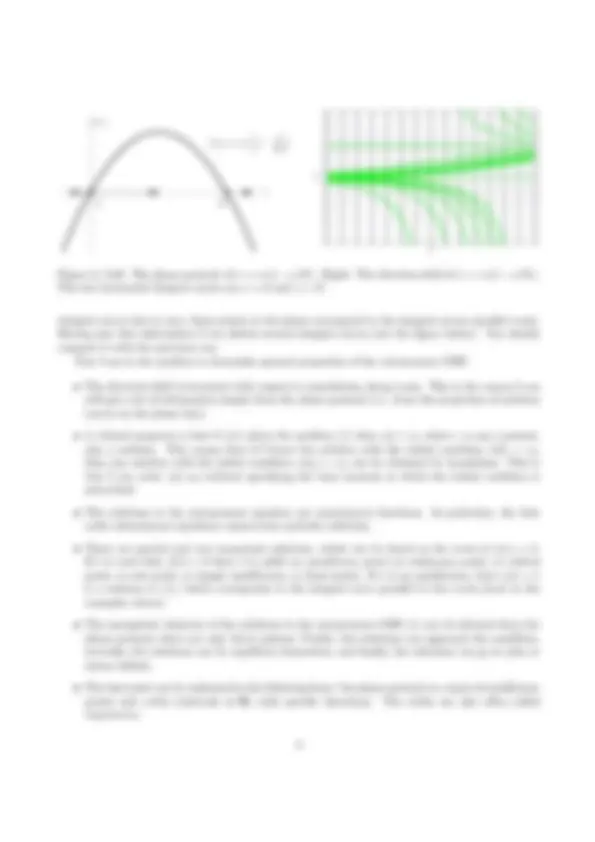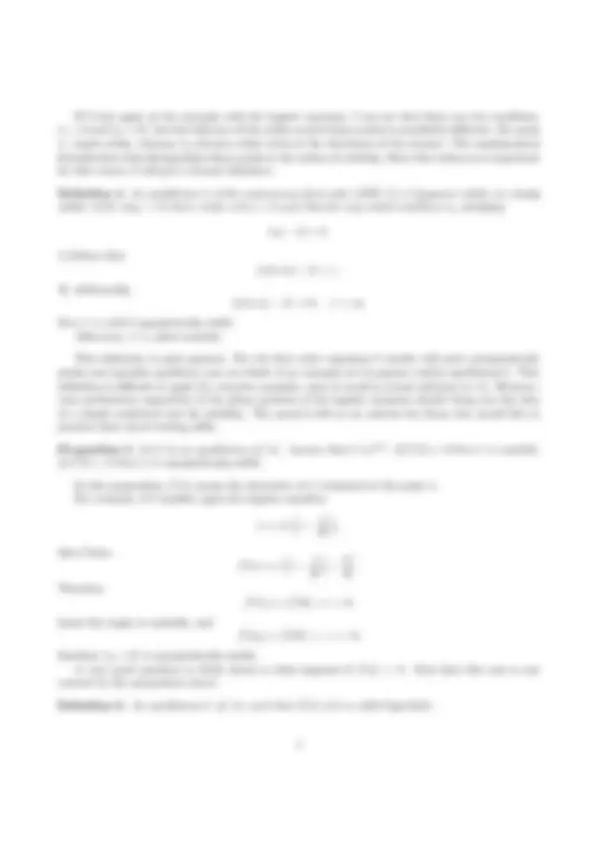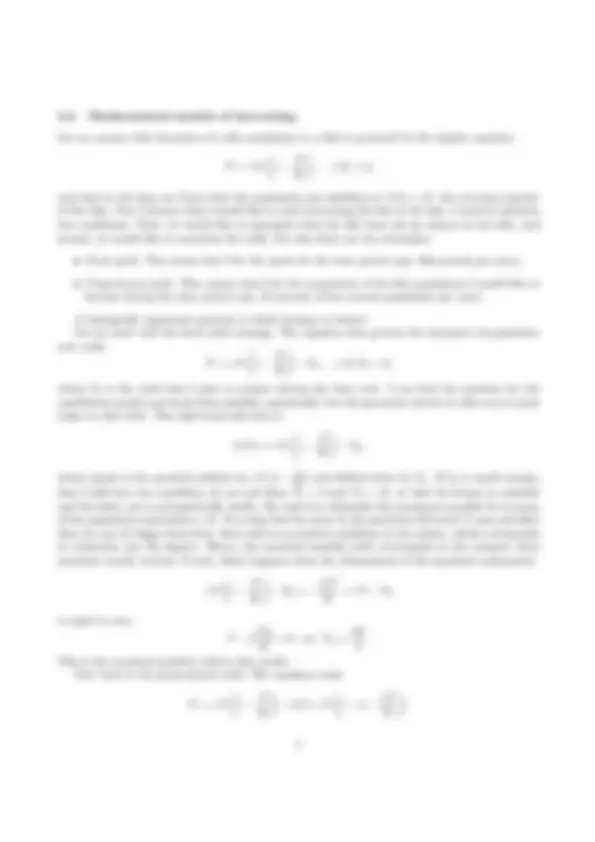





Study with the several resources on Docsity

Earn points by helping other students or get them with a premium plan


Prepare for your exams
Study with the several resources on Docsity

Earn points to download
Earn points by helping other students or get them with a premium plan
Community
Ask the community for help and clear up your study doubts
Discover the best universities in your country according to Docsity users
Free resources
Download our free guides on studying techniques, anxiety management strategies, and thesis advice from Docsity tutors
The mathematical properties of autonomous first order Ordinary Differential Equations (ODEs) and demonstrates their application to analyzing a biological problem using the logistic equation. the definitions and basic properties of autonomous ODEs, the concept of phase portraits, and the analysis of equilibrium points and their stability. It also introduces the concept of harvesting dynamics in a fish population model and calculates the maximal possible yield.
What you will learn
Typology: Study notes
1 / 7

This page cannot be seen from the preview
Don't miss anything!




I start with some mathematical properties of the first order ODE and after this will show how one can put them to a good use analyzing a biological problem.
Definition 1. First order ODE x˙ = f (t, x) is called autonomous if the right hand side does not depend explicitly on t: x ˙ = f (x). (1)
I start with an example, and then generalize the properties deduced in this example to all au- tonomous equations.
Example 2. Consider the simplest autonomous equation
x˙ = x,
which is a separable equation, and whose solution is
x(t) = Cet,
where C is an arbitrary constant. If I had the initial condition x(t 0 ) = x 0 , then my solution would be
x(t; x 0 ) = x 0 et−t^0.
If one has the explicit formula for the solution then it is easy to sketch several integral curves (i.e., the graphs of the solutions) and the direction field of this equation (see the figure).
x
x
t
Figure 1: The direction field of ˙x = x together with the phase line. The dashed arrows show the projection of the direction field onto the x-axis
From the figure it becomes obvious that the direction field of the equation in the example, as well as any direction field of the autonomous equations, have the property that it is the same on any line
Math 484/684: Mathematical modeling of biological processes by Artem Novozhilov e-mail: artem.novozhilov@ndsu.edu. Fall 2015
parallel to t axis. Hence I can project the whole direction field onto the x-axis, without losing much information (I put an arrow that points in the positive direction if the slope is positive and an arrow that points in the negative direction if the slope is negative, what lost is the absolute values of the slopes). The picture on the x-axis is called the phase portrait and the x axis is called the phase line (again, the terminology originated in mechanics). Note that for x = 0 there is no direction and hence I mark this point on the phase line. Can I come up with the phase portrait without looking at the direction field, which was known to me because of the simplicity of the original equation? The answer is resounding “yes.” Consider the following figure. Here I look at the function f , which is simply f (x) = x in my case. Note that if x > 0 then f (x) > 0 hence x >˙ 0 hence the solutions are increasing. Similarly, if x < 0, then x <˙ 0 and solutions are decreasing, I point these facts with arrows in the graph and obtain again the same phase portrait that I already saw in the previous figure. Hence the conclusion: We do not need actual analytical (i.e., in the form of a formula) solutions to the autonomous differential equations to figure out the phase portrait of this equation. And knowledge of the phase portrait allows me to infer the asymptotic behavior of the solutions (“asymptotic” in this context means for t → ∞). In my example I see that if the initial condition x 0 > 0 then x(t; x 0 ) → ∞ for t → ∞, and if x 0 < 0 then x(t; x 0 ) → −∞. Here and throughout the course the notation x(t; x 0 ) means the solution to ODE with the initial condition x 0.
f (x)
x
f (x) = x
f (x) > 0
f (x) < 0
Figure 2: The phase portrait of ˙x = x
Example 3. Here is another example: the logistic equation has the form
x˙ = rx
x K
, r, K > 0.
Here r, K are positive parameters. I actually solved this equation and studies its solutions in the previous lecture. Here I will sketch several integral curves by studying its phase portrait. The graph of f (x) = rx(1 − x/K) is a parabola with branches pointing down, which crosses x-axis at the points xˆ 1 = 0 and ˆx 2 = K (see the figure).
I can see that f (x) is negative when x < 0 and x > K and positive for x ∈ (0, K), hence the directions of the arrows. This means that the integral curves are growing for x ∈ (0, K) and degreasing for x < 0 and x > K. If x = 0 or x = K I have that f (x) = 0, and hence the slope of the
If I look again at the example with the logistic equation, I can see that there are two equilibria: xˆ 1 = 0 and ˆx 2 = K, but the behavior of the orbits around these points is manifestly different: the point xˆ 1 repels orbits, whereas ˆx 2 attracts orbits (look at the directions of the arrows). The mathematical formalization that distinguishes these points is the notion of stability. Since this notion is so important for this course, I will give a formal definition.
Definition 4. An equilibrium ˆx of the autonomous first order ODE (1) is Lyapunov stable (or simply stable) if for any ε > 0 there exists a δ(ε) > 0 such that for any initial condition x 0 satisfying
|x 0 − ˆx| < δ,
it follows that |x(t; x 0 ) − xˆ| < ε.
If, additionally, |x(t; x 0 ) − xˆ| → 0 , t → ∞,
then xˆ is called asymptotically stable. Otherwise, xˆ is called unstable.
This definition is quite general. For the first order equations I mostly will meet asymptotically stable and unstable equilibria (can you think of an example of a Lyapunov stable equilibrium?). This definition is difficult to apply for concrete examples, since it involves actual solutions to (1). However, even perfunctory inspection of the phase portrait of the logistic equation should bring you the idea of a simple analytical test for stability. The proof is left as an exercise for those who would like to practice their proof writing skills.
Proposition 5. Let xˆ be an equilibrium of (1). Assume that f ∈ C(1). If f ′(ˆx) > 0 then xˆ is unstable; if f ′(ˆx) < 0 then ˆx is asymptotically stable.
In this proposition f ′(ˆx) means the derivative of f evaluated at the point ˆx. For example, if I consider again the logistic equation
x˙ = rx
x K
then I have f ′(x) = r
x K
rx K
Therefore f ′(ˆx 1 ) = f ′(0) = r > 0 ,
hence the origin is unstable, and f ′(ˆx 2 ) = f ′(K) = −r < 0 ,
therefore ˆx 2 = K is asymptotically stable. A very good question to think about is what happens if f ′(ˆx) = 0. Note that this case is not covered by the proposition above.
Definition 6. An equilibrium xˆ of (1) such that f ′(ˆx) ̸= 0 is called hyperbolic.
Let me assume that dynamics of a fish population in a lake is governed by the logistic equation
N˙ = rN
, r, K > 0 ,
such that in the long run I have that the population size stabilizes at N (t) = K, the carrying capacity of the lake. Now I assume that I would like to start harvesting the fish in the lake. I need to optimize two conditions: First, we would like to guarantee that the fish does not go extinct in the lake, and second, we would like to maximize the yield. For this there are two strategies:
A biologically important question is which strategy is better? Let me start with the fixed yield strategy. The equation that governs the dynamics of population now reads
N˙ = rN
− Y 0 , r, K, Y 0 > 0 ,
where Y 0 is the yield that I plan to acquire during the time unit. I can find the equation for the equilibrium points and study their stability analytically, but the geometric picture in this case is much easier to deal with. The right hand side here is
f (N ) = rN
whose graph is the parabola defined by rN
and shifted down by Y 0. If Y 0 is small enough,
then I still have two equilibria, let me call them Nˆ 1 > 0 and Nˆ 2 < K, at that the former is unstable and the latter one is asymptotically stable. My task is to determine the maximum possible Y 0 in terms of the population parameters r, K. It is clear that for some Y 0 the parabola will touch N -axis and after that, for any Y 0 bigger than that, there will be no positive equilibria in the system, which corresponds to extinction (see the figure). Hence, the maximal possible yield corresponds to the moment when parabola exactly touches N -axis, which happens when the determinant of the quadratic polynomial
rN
rN 2 K
is equal to zero:
r^2 − 4
rY 0 K
rK 4
This is the maximal possible yield in this model. Now back to the proportional yield. The equation reads
N˙ = rN
− hN = N
r − h −
rN K
f (x)
x
h = 0
0 K
h = h(2)
h = h(1)
h = h(3)
Figure 5: The phase portraits for the model with the proportional yield. h(1)^ < h(2)^ < h(3)^ < r. Note that for any h < r we still have two equilibria, the right of which is asymptotically stable